Related Research Articles

Cuirassiers were cavalry equipped with a cuirass, sword, and pistols. Cuirassiers first appeared in mid-to-late 16th century Europe as a result of armoured cavalry, such as men-at-arms and demi-lancers discarding their lances and adopting pistols as their primary weapon. In the later part of the 17th century, the cuirassier lost his limb armour and subsequently wore only the cuirass, and sometimes a helmet. By this time, the sword or sabre had become his primary weapon, with pistols relegated to a secondary function.
The Light Division is a light infantry division of the British Army. It was reformed in 2022, as part of Future Soldier reforms.

A military column is a formation of soldiers marching together in one or more files in which the file is significantly longer than the width of ranks in the formation. The column formation allows the unit rapid movement and a very effective charge, and it can quickly form square to resist cavalry attacks, but by its nature only a fraction of its muskets are able to open fire.
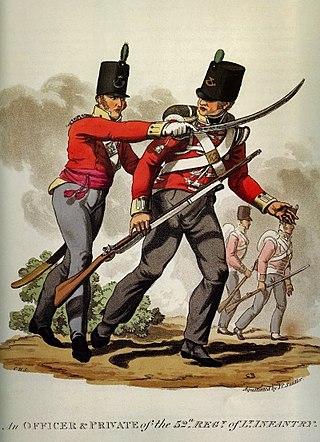
The Coalition forces of the Napoleonic Wars were composed of Napoleon Bonaparte's enemies: the United Kingdom, the Austrian Empire, Kingdom of Prussia, Kingdom of Spain, Kingdom of Naples, Kingdom of Sicily, Kingdom of Sardinia, Dutch Republic, Russian Empire, the Ottoman Empire, Kingdom of Portugal, Kingdom of Sweden, and various German and Italian states at differing times in the wars. At their height, the Coalition could field formidable combined forces of about 1,740,000 strong. This outnumbered the 1.1 million French soldiers. The breakdown of the more active armies are: Austria, 570,000; Britain, 250,000; Prussia, 300,000; and Russia, 600,000.
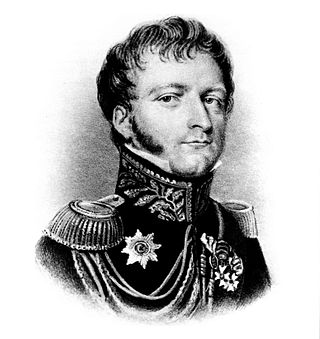
Major-General August von Kruse, was a general in the army of the Duke of Nassau during the Napoleonic Wars and an experimental farmer in his retirement.

The voltigeurs were French military skirmish units created in 1804 by Emperor Napoleon I. They replaced the second company of fusiliers in each existing infantry battalion.
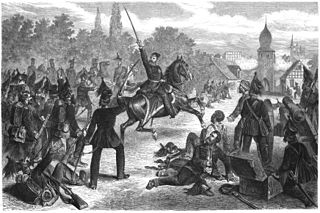
The Brunswick Ducal Field-Corps, commonly known as the Black Brunswickers in English and the Schwarze Schar or Schwarze Legion in German, were a military unit in the Napoleonic Wars. The corps was raised from volunteers by German-born Frederick William, Duke of Brunswick-Wolfenbüttel (1771–1815). The Duke was a harsh opponent of Napoleon Bonaparte's occupation of his native Germany. Formed in 1809 when war broke out between the First French Empire and the Austrian Empire, the corps initially comprised a mixed force, around 2,300 strong, of infantry, cavalry and later supporting artillery.
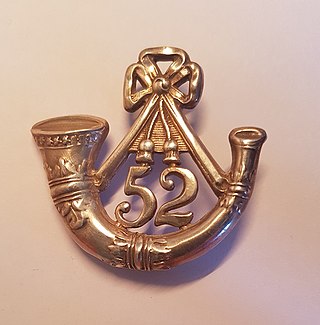
The 52nd (Oxfordshire) Regiment of Foot was a light infantry regiment of the British Army throughout much of the 18th and 19th centuries. The regiment first saw active service during the American War of Independence, and were posted to India during the Anglo-Mysore Wars. During the Napoleonic Wars, the 52nd were part of the Light Division, and were present at most major battles of the Peninsula campaign, becoming one of the most celebrated regiments, described by Sir William Napier as "a regiment never surpassed in arms since arms were first borne by men". They had the largest British battalion at Waterloo, 1815, where they formed part of the final charge against Napoleon's Imperial Guard. They were also involved in various campaigns in India.
David Geoffrey Chandler was a British historian whose study focused on the Napoleonic era.

The British Army during the Napoleonic Wars experienced a time of rapid change. At the beginning of the French Revolutionary Wars in 1793, the army was a small, awkwardly administered force of barely 40,000 men. By the end of the period, the numbers had vastly increased. At its peak, in 1813, the regular army contained over 250,000 men. The British infantry was "the only military force not to suffer a major reverse at the hands of Napoleonic France."

Horses were widely used during the Napoleonic Wars for combat, patrol and reconnaissance, and for logistical support. Vast numbers were used throughout the wars. During the War of the Sixth Coalition, depletion of the French cavalry arm through attrition and loss of horse-producing allies to provide remounts contributed significantly to the gradual French defeat and downfall of the French Empire. During the Waterloo Campaign, the Armée du Nord had 47,000 horses: 25,000 cavalry, 12,000 for artillery, 10,000 for infantry and supply columns.
Digby George Smith, who also used the pseudonym Otto von Pivka, was a British military historian. The son of a British career soldier, he was born in Hampshire, England, but spent several years in India and Pakistan as a child and youth. As a "boy soldier", he entered training in the British Army at the age of 16. He was later commissioned in the Royal Corps of Signals, and held several postings with the British Army of the Rhine.

Arthur Wellesley, 1st Duke of Wellington,, was one of the leading British military and political figures of the 19th century. Often referred to solely as "The Duke of Wellington", he led a successful military career in the Indian subcontinent during the Fourth Anglo-Mysore War (1798–99) and the Second Anglo-Maratha War (1803–1805), and in Europe during the Napoleonic Wars (1803–1815).
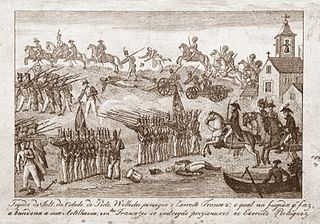
The Anglo-Portuguese Army was the combined British and Portuguese army that participated in the Peninsular War, under the command of Arthur Wellesley. The Army is also referred to as the British-Portuguese Army and, in Portuguese, as the Exército Anglo-Luso or the Exército Anglo-Português.
Between 1793 and 1815, under the rule of King George III, the Kingdom of Great Britain was the most constant of France's enemies. Through its command of the sea, financial subsidies to allies on the European mainland, and active military intervention in the Peninsular War, Britain played a significant role in Napoleon's downfall.
References
- ↑ Professor Charles J. Esdaile, School of History, University of Liverpool
- ↑ Royal Historical Society
- ↑ Commission for Military History
- ↑ Peninsular War 200 was the official UK organisation for the commemoration of the Peninsular War - President : General Sir Nick Parker